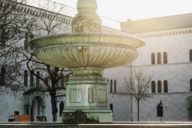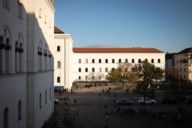
The Ludwig Maximilian University (LMU) is one of the top universities in the world. You only have to look at the degree courses and number of students – and even Nobel Prize winners – to realise the LMU is the ultimate fountain of knowledge.
The figures are incredible: Around 700 professors teach over 50,000 students in around 150 subjects at the LMU. The LMU has produced just under three dozen Nobel Prize winners. It undoubtedly has a great reputation. Munich’s flagship university has steadily become the ultimate fountain of knowledge over the years.
And the LMU wasn’t even based in the Bavarian state capital for a long time. It all began several hundred years ago around 80 kilometres further north. The “High School of Old Bavaria” was founded in Ingolstadt in 1472 by Duke Ludwig IX, after whom the university was partly named. The range of subjects was quite straightforward: Medicine, Law and Theology.
The university got its current name during a stopover in Landshut in 1802. Its name honours the founder and reigning Maximilian IV Joseph. King Ludwig I finally brought the university to Munich in 1826. He wanted to have it as close as possible to the political and cultural centre.

The LMU’s opulent main building was designed by Friedrich von Gärtner and opened in 1840 right next to the Siegestor (gate) on Ludwigstrasse. You can still sense an aura of history as you stand and admire the mighty forecourt with its 8.2-metre-high fountain. One such moment in history was the king’s affair with the dancer Lola Montez, which led to riots and the brief closure of the LMU in 1848. Women also went on to play a key role at the university, as female students received their first doctorates in 1900 and the first woman qualified for a senior lecturing post in 1918.

In the 19th century alone, the university produced talented minds like the chemist Adolf von Baeyer, the winner of the Nobel Prize in Physics Wilhelm Röntgen, and physician Max von Pettenkofer. Less emphasis is placed on the events that happened during the Second World War. In 1942, a resistance movement against the Nazi dictatorship was held on the square in front of the main building at the LMU. Students distributed leaflets calling for the end of the Hitler regime. Geschwister-Scholl-Platz and Professor-Huber-Platz are two squares named in honour of the protagonists of the resistance of the “White Rose”. The siblings Hans and Sophie Scholl, Professor Kurt Huber and other students were executed by the Nazis in 1943.
The university had to be completely closed for a while after the Second World War. Large amounts of the main building were destroyed during a bombing raid in 1944, and classes were either taught amongst the rubble or in professors’ private rooms. The LMU then suspended all activities in May 1945 following the arrival of the US troops. The university reopened its doors to students for the first regular post-war semester on April 1, 1946.
A lot has changed at the university since then. The LMU has managed to expand its research profile thanks to its success in the Excellence Initiative for the promotion of science. During the second phase of the Excellence Initiative in 2012, it even emerged as the most successful university in Germany. Its cooperation with US and Chinese universities has also boosted its reputation on the international stage. Lots of foreign students are now delighted to study in Munich.
But if you think you’ll be able to attend lectures in one of the magnificent halls found in the main building at Geschwister-Scholl-Platz, you might not get quite what you were hoping for… Most of the faculties are now located throughout the university quarter in Schwabing, or even in Garching or Oberschleissheim.